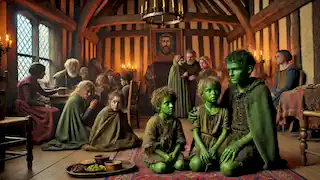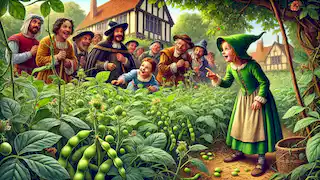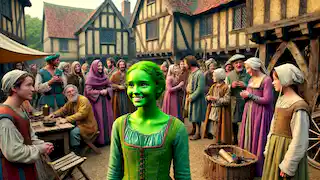Introduction
In the ancient English village of Woolpit, nestled in the county of Suffolk, a mysterious and enigmatic legend has been passed down through generations: the tale of the Green Children of Woolpit. This story, dating back to the 12th century, has baffled historians and storytellers alike for centuries. It speaks of two children, a brother and sister, who were found near the village one day, their skin a striking green color, speaking an unknown language, and wearing clothing made of strange materials. As they integrated into the community, questions about their origin remained. Were they lost children from a distant, unknown land? Or was their arrival tied to something otherworldly? The tale of the Green Children of Woolpit raises more questions than it answers, but it continues to captivate the imagination of all who hear it.
The Mysterious Arrival
One day during the reign of King Stephen, the farmers of Woolpit were working in their fields, which surrounded the protective wolf pits that gave the village its name. These pits were designed to trap wolves, a common threat to the livestock. The day was bright, the sun high in the sky, when a few farmers heard what they described as a "strange, muffled sound" coming from one of the deeper pits.
Curious, they approached the pit cautiously, unsure of what they would find. As they neared the pit’s edge, they peered down and saw two small figures huddled together at the bottom. The figures were unlike any children they had ever seen. Their skin was a strange shade of green—deep and vibrant. Their hair was long, and they wore clothing made from a material the farmers did not recognize, with colors and patterns that seemed foreign.
The children, a boy and a girl, appeared scared and confused. They were speaking in a language that none of the villagers could understand, and their eyes darted around in fear as the farmers lowered a rope to pull them out. Once out of the pit, the villagers attempted to communicate with the children, but their words were incomprehensible. Still, they were children, and the people of Woolpit could see that they were hungry and tired.
Despite their initial shock at the green skin and strange language, the villagers took the children to the home of a local nobleman, Sir Richard de Calne, where they would be given food and shelter. However, things grew even stranger when the children refused to eat any of the food they were offered. Bread, meat, fruit—everything was refused, though they appeared to be starving.

The Children’s Struggles
As days passed, the villagers grew increasingly concerned. The children were becoming weak from hunger, and no one could figure out what to feed them. They continued to speak in their strange language, huddling close to one another, as if fearful of their new surroundings. The villagers tried their best to communicate, but no progress was made.
It wasn’t until one day, as the children were wandering near a vegetable garden, that they spotted something familiar—beans. They eagerly pointed to a patch of broad beans growing in Sir Richard's garden, and when they were offered the raw beans, they devoured them hungrily. From that day on, broad beans became their primary source of nourishment, and the villagers ensured that they always had plenty to eat.
As the weeks passed, the children began to adapt to their new life in Woolpit. Slowly but surely, they started learning the English language. The boy, however, remained frail and weak. His health, which had been poor from the start, worsened over time, and despite the villagers’ best efforts, he eventually passed away, leaving the girl alone in her strange new world.
Grief-stricken but resilient, the girl continued to live with Sir Richard de Calne. Over time, her green hue began to fade, and she grew more accustomed to the food and customs of her new home. She thrived under Sir Richard's care, becoming a healthy young woman. Her once incomprehensible language was replaced with English, and soon, she was able to share her story with the villagers.
The Origin of the Green Children
As the girl grew older and more proficient in English, she began to recount the tale of her and her brother’s mysterious origins. She described the place where they had come from—a land that was always in twilight, a perpetual state of dusk. In this strange land, the sun never shone brightly, and the sky remained dim, casting a greenish hue over everything. She explained that everyone in their homeland had green skin like theirs and that they had lived peacefully in a place called "St. Martin’s Land."
The girl described how she and her brother had been tending their family’s flock of sheep when they wandered into a cave. They heard the sound of bells, which lured them further into the cave, and before they knew it, they were lost in the darkness. After what seemed like an eternity, they emerged from the cave to find themselves in the bright light of the Woolpit countryside. Disoriented and frightened by the sudden change in their surroundings, they tried to find their way back but ended up falling into the pit where the villagers discovered them.
Though the girl tried to explain more about St. Martin’s Land, her descriptions remained vague and otherworldly, leaving many questions unanswered. Was this land a real place? Was it a different realm or dimension? The villagers listened intently to her story but remained puzzled.

Theories and Interpretations
The story of the Green Children of Woolpit soon spread beyond the village, capturing the attention of scholars, chroniclers, and historians. Many have attempted to explain the strange circumstances of the children’s arrival and their green skin, but no definitive answers have ever been found.
One popular theory suggests that the children may have been Flemish immigrants who had become lost and disoriented. During this time, many Flemish people were fleeing persecution in England, and some scholars believe that the children could have been orphaned refugees. The green hue of their skin, according to this theory, could have been due to malnutrition, particularly from a diet deficient in iron, which can cause a condition known as "green sickness." This would explain why the girl’s skin returned to a normal color after she began eating a more varied diet.
Others, however, believe that the story of the Green Children is not based in reality but rather a metaphor or allegory. Some interpretations suggest that the tale represents the cultural and religious tensions of the time, while others see it as a story about the innocence and purity of childhood, with the green skin symbolizing a connection to nature and the unknown.
There are also those who believe the story to be a folktale or myth, with roots in the pagan traditions of England. The children’s connection to a mysterious, twilight land could be linked to older beliefs in faerie realms or parallel worlds that exist alongside our own.
Still, the most imaginative interpretations of the story suggest that the children were not from this world at all, but from another planet or dimension. The idea that they came from a place with dim light, leading to their green skin, aligns with theories about extraterrestrial life and the possibility of other inhabited worlds.
Life After Woolpit
After the boy’s tragic death and the girl’s adaptation to life in Woolpit, she went on to live a relatively normal life. She grew up in the care of Sir Richard de Calne and became well-respected within the village. Eventually, she married a local man, and though her past was shrouded in mystery, she seemed content to live the rest of her life as part of the Woolpit community.
Some accounts even suggest that she became a mother, with her children showing no signs of the green skin that had once marked her and her brother as different. The story of the Green Children of Woolpit became a distant memory, though it was never entirely forgotten by the villagers.

Legacy of the Green Children
Though centuries have passed since the Green Children of Woolpit appeared in the village, their story has endured. It has been retold in numerous versions, each adding its own layer of interpretation and speculation. Historians and folklorists continue to debate the meaning and origin of the tale, and it remains one of the most intriguing and unsolved mysteries in English history.
In Woolpit itself, the story is still celebrated, and the village has become something of a tourist attraction for those interested in folklore and the unexplained. The wolf pits from which the village takes its name are long gone, but the memory of the Green Children lives on.
Visitors to Woolpit can walk the same fields where the children were said to have been found and explore the local church, which dates back to the same period. The church itself contains no direct references to the Green Children, but its ancient walls have borne witness to the village's long and mysterious history.
Over the years, the Green Children have become symbols of the unknown, representing the mysteries that still lie beyond human understanding. Their story serves as a reminder that not everything in the world can be explained by logic or reason, and that there will always be room for wonder and imagination.
The Enduring Mystery
Despite the many theories and attempts to explain the Green Children of Woolpit, the mystery remains unsolved. Were they refugees from a far-off land? Survivors of persecution? Or did they truly come from another world, as their strange appearance and baffling story might suggest?
Even today, as science and technology advance, there are still countless mysteries that elude explanation. The Green Children of Woolpit stand as a testament to the enduring power of folklore and the human fascination with the unknown. Their story reminds us that sometimes the most important questions are those that cannot be answered.
And so, the Green Children of Woolpit remain a part of England
’s rich tapestry of legends and myths—green-skinned visitors from a place beyond our understanding, who walked out of the twilight and into the light of history, leaving behind more questions than answers.




















